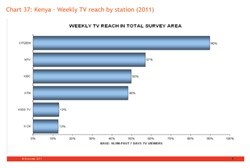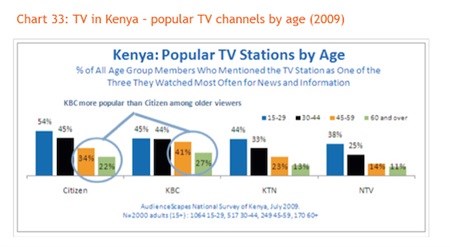In Africa, there are a few audience measurement research firms that collect and market television ratings' data. I had a look at the state of the market and the implications of TV audience measurement in Africa.
Back in 2012 (see above and below graphics, audience data from Synovate, extract from from African Broadcast and Film Markets - 2nd edition - Feb. 2012) Balancing Act identified 18 major media audience research firms active across Africa.
However, media audience market research is costly and therefore there is no regular annual research on all but the larger sub-Saharan African countries. For individual countries, aid agencies and NGOs occasionally carry out one-off research exercises in countries like Sierra Leone and South Sudan.
TV audience measurement tells how many people are in an audience in relation to total television viewership. Since more and more Africans watch web TV and VOD portals online, web traffic on websites should also be measured and released alongside other viewing data.
More accurate idea of media reach
Commercial market research companies (like Ipsos Synovate, TNS Sofres and Nielsen) carry out regular surveys in a small number of countries including: Angola, Ghana, Kenya, Namibia, Nigeria, South Africa, Tanzania and Uganda. The financial basis of this research is that media owners and advertising brands pay for it to get a more accurate idea of media reach.
But much of the research is only conducted on a monthly (at the best) or quarterly basis (if not annually) and does not track individual programmes. Pan-African sponsors and advertisers frequently bewail the lack of accurate data to address pan-continental advertising campaign planning.
According to the audience data that we gathered from various firms, audience levels across Africa are similar to audience trends around the world: Prime time (the highest audience times) runs from 7pm to 11pm which includes Access Prime time (7pm to 8pm) and Peak Time (8pm to 10/11pm).
Football audiences in Africa also follow similar patterns as in the West (get gender data in Balancing Act's just published 'African Sports TV market' report)
Lack of regular, detailed audience measurements
But lack of regular and detailed audience measurements in most countries prevent a majority of African TV channels from attracting advertising and sponsors. Without precise audience data by TV programme and time of the week, it is also difficult to understand what the national TV audience watches most and which TV programme needs to be acquired by TV channels.
What's more, very few countries have basic audience data released publicly on the web. Besides, VoD and WebTV traffic in Africa rarely gets released.
South Africa is an exception: SAARF (the South African Audience Research Foundation) has done an amazing job on its website in providing detailed audience measurement for key media.
In the early seventies, a small group of far-sighted persons from the marketing, media and advertising communities realised that there was a need for a comprehensive, unbiased, reliable, regular and technically excellent survey: SAARF was born.
SAARF's main objective is to direct and publish media audience and product/brand research for the benefit of its stakeholders, thereby providing data for target marketing and a common currency for the buying and selling of media space and time.
SAARF's portal explains that "SAARF receives an annual endowment from two sources, the Media and Marketing Collection Agency (MAMCA) and the PMSA (representing Print). These bodies also support another important industry body, the Advertising Standards Authority (ASA).
The financing from MAMCA is obtained via an industry levy on advertising expenditure. The PMSA contributes an agreed amount. The collection of the levy is a relatively straightforward process, as it is collected by media owners on behalf of the industry. The levy is calculated after all discounts and agency commissions have been deducted, the so-called net-net levy."
Difficulties getting sponsors, advertising
In other countries, without detailed and up-to-date audience data, TV channels will continue to have difficulties getting sponsors and advertising.
Back in February 2014, Gabon implemented a system for measuring Radio and Television audiences as part of its "programme du Plan Stratégique Gabon Emergent" (PSGE). The official launch ceremony took place on 6 February 2014 at the "Maison Georges RAWIRI", housing the offices of Radio Gabon and Gabon Television. Experts from Médiamétrie (Paris) and Omedia (Dakar) formed a JV which won a public tender from the Minister of Digital Economy, Communication and Post in Gabon.
To inaugurate their mission, Henri False, Nicolas Gwilherm (Médiamétrie) and Christophe Gondry (Omedia) presented the study to the Minister of Digital Economy, Communication and Post in Gabon, Pastor Ngoua N'Neme.
Médiamétrie is also performing audience measurement surveys in Côte d'Ivoire, Senegal, DRC, Madagascar and Morocco.
The structure of the media industry in Africa changes every month with the introduction of new media such as satellite DTH and DTT platforms, new channels, pay TV bouquets, or increase use of VoD and web TV portals. This creates fragmentation and a proliferation of media in each African country. The end result is a bewildering array of media choices for both the consumer and for the advertiser.
Crucial issue
Audience data is therefore essential to the development of advertising revenues for TV channels whether public or private, which should now face tougher competition.
Audience measurement is also a crucial issue for both public authorities (tax, public TV channels, communication, universal access to information, building a strong media sector, employment, etc.) and businesses wishing to promote their services through audiovisual media.
The cost of audience market research is always held up as the key obstacle to getting this kind of information. However, there are other factors that are much harder to change. Advertising agencies do not always buy media on the basis of audience data even where it exists.
Often there are cosy relationships between individuals on both sides of the broadcaster and agency divide. There are also dark rumours of 'under-the-counter' payments to get advertising in some countries. Smaller TV stations stay in business longer if no-one knows quite how small their audiences are.
African TV stakeholders need to cooperate to review available media today, produce regular audience research and investigate what the national television scene will look like in five years from now, as there are huge implications for the ongoing audience measurement.
National broadcast regulators may have a role to play in insisting that licensed broadcasters provide regular (e.g. quarterly) statistics on key issues such as TV audience share (for example through contributing to regular and neutral national audience surveys).
They can bring pressure to bear on TV companies to professionalise themselves and to treat audience data costs as a vital part of running their business.
Source: Balancing Act































